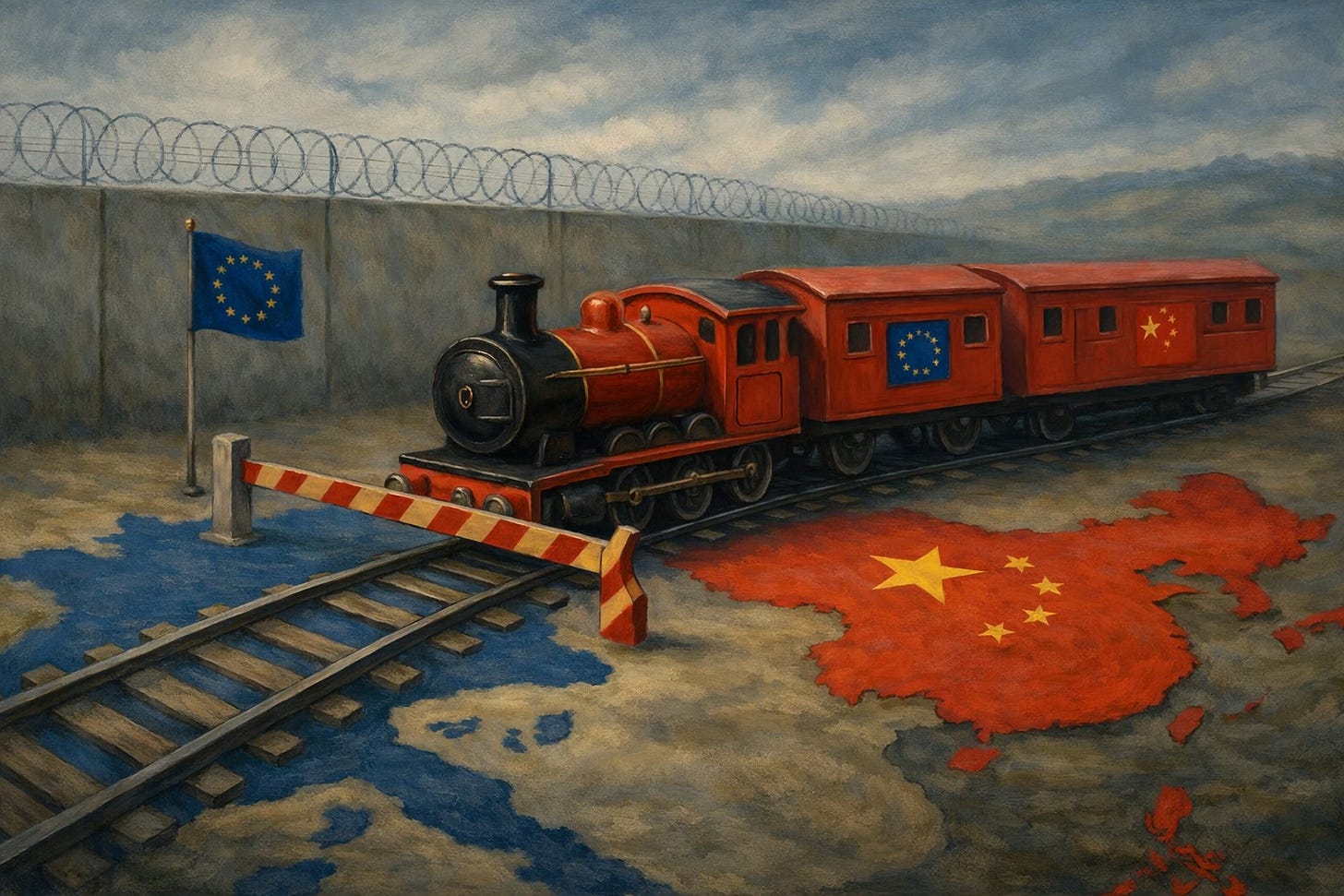Poland Closes, China Pays: Price It In
A border shutdown turned the China–EU rail into a policy tool. Assume repeats and plan volumes.
Poland slammed one gate and exposed a €25 billion single point of failure between China and Europe.
Warsaw didn’t disrupt a corridor. It cut an artery and dared Beijing to stop it. For 13 days in September, Poland sealed the Małaszewicze-Brest crossing, the beating heart of the China-Europe Railway Express, and confirmed what the Belt and Road sales pitch omits: this route runs across a live security frontier, not a neutral marketplace.
Poland just put a permanent geopolitical risk premium on China-Europe rail.
Małaszewicze handles about 90% of all China-EU rail freight. In 2024, cargo value on the route jumped 85% to roughly €25.07 billion, lifting rail’s share of EU-China trade to 3.7%. Around 60% of loads are electronics, machinery, lithium batteries, and EVs — time-sensitive cargo that doesn’t tolerate delay.
Trigger: a Sept 9-10 swarm of 19-23 Russian drones transiting via Belarus, followed by Zapad-2025 drills on Poland’s doorstep. NATO jets scrambled; several drones were shot down. Warsaw treated it as deliberate, not accidental, and chose defense over commerce.
Decision: close all road and rail crossings with Belarus, including the Terespol/Małaszewicze rail hinge, until the safety of Poles is fully guaranteed. Reopen only when conditions are safe.
Operational shock followed immediately. Trains stacked up from Brest eastward. Forwarders absorbed penalties. Ocean carriers priced in risk; a 40’ high-cube via the Baltics ran to about $9,500.
Diplomacy ran in parallel. China’s Wang Yi flew to Warsaw calling the Express a flagship and pushing to reopen. Poland flipped the script: if Beijing wants trains moving, Moscow and Minsk need to stop the games. Beijing skipped a joint press conference. Warsaw reopened after Zapad ended, on its own timeline, and warned it will shut the gate again if needed.
Cost tally for the 13-day halt: roughly €893 million in delayed or rerouted goods, excluding secondary hits like emergency airlifts, line stoppages, and missed launches.
Beijing-aligned voices argue Poland bowed to NATO pressure and hurt Europe by stranding trains, juicing inflation, kneecapping EU firms. They’re right about one thing: the closure was costly, and the Express carries high-value cargo Europe wants fast.
But the case collapses on the facts. Poland acted after a documented airspace violation and major exercises simulating conflict on its border. EU signals framed the shutdown as a security response to Russian behavior, not Polish protectionism. China’s demarche failed. Warsaw reopened after its own services finished their review, and kept the option of future closures explicit. That’s sovereignty, not subservience.
Picture the room at the crossing. Interior Minister Marcin Kierwiński lays down the line: traffic resumes only when the safety of Poles is fully guaranteed. Across the table, the Chinese line is familiar: the Express is a flagship that benefits both sides. The trains sit. The costs mount. Three hours of very frank talks later, Warsaw doesn’t budge.
The barbed wire at Poland’s edge not only blocks cargoes, but also undermines the trust that keeps globalization running, wrote Huazhijiao, a Sichuan-based commentator.
Trust cuts both ways.
Follow the incentives. Poland is a NATO frontline state. Its first job is to keep Russian and Belarusian provocations out of Polish airspace. The logic of security now outranks the logic of trade, and that choice bakes a standing risk premium into the Northern Corridor. Insurers will reprice. Shippers will carry more buffer stock. The all-in cost of using this route just rose, and it’s not reverting.
China has to de-risk. Building around a single gate that a NATO member can close at will is a strategic flaw. Expect acceleration on the China-Kyrgyzstan-Uzbekistan railway (about 900 km shorter and bypassing Russia) and a political push to bulk up the Middle Corridor despite ferries, multiple handoffs, and hard capacity ceilings.
Europe’s takeaway is equally blunt: if Brussels wants resilient supply, it has to fund the chokepoints on the Trans-Caspian route and keep the eastern flank fortified. Otherwise, the next drone swarm sets the price of your washing machine.
Stop pretending this was a one-off. Warsaw just turned border closure into a usable policy tool, and said so. Plan freight as if closures will recur. Split volumes across corridors. Pre-book Middle Corridor capacity even when it hurts — tuition for resilience. And price the Northern Route honestly, with politics baked in.
Notes on Uncertainties
• Drone count remains a range (19-23). The episode reads as a coordinated swarm but doesn’t fix a single number.
• The €893 million figure is a conservative estimate based on average daily trade value; secondary costs (line stoppages, airfreight premiums, spoilage) aren’t fully quantified.
• Baltic and Middle Corridor rate spikes and transit times are directionally clear; precise capacity elasticities aren’t modeled.



Really appreciate such a detailed breakdown - a few points here genuinely broaden my perspective on what happened in September. I've been following the Małaszewicze issue and Poland geo-economic potential for a while now, especially since, as a Polish observer with a multipolar outlook. I see BRI as an opportunity, rather than a threat. This episode, however, seems to narrow that opportunity quite significantly.
In my own analysis, I focused on a different angle: that the shutdown didn't disrupt flow, but may have permanently shaken Beijing's trust in Poland as a partner - pushing China to accelerate long-term route diversification away from Poland, with Russia and alternative corridors emerging as the unexpected winner.
If you're interested in that more structural long-term perspective, here's my take:https://ceap2040.substack.com/p/the-malaszewicze-blunder-how-poland
Would be very interested to hear how you see Poland's leverage evolving after this episode.
This is the way to stand up to these thugs. Kick them where it hurts.